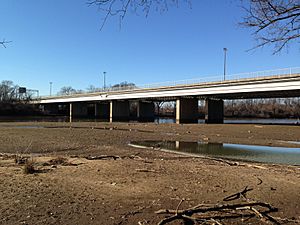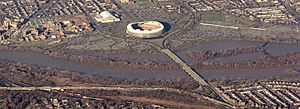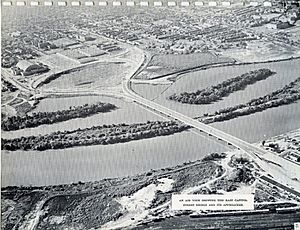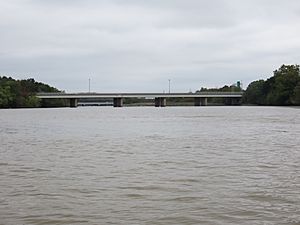Whitney Young Memorial Bridge facts for kids
Quick facts for kids Whitney Young Memorial Bridge |
|
|---|---|

The Whitney Young Bridge from the south in 2015
|
|
| Coordinates | 38°53′23″N 76°57′54″W / 38.889764°N 76.964979°W |
| Carries | Motor vehicles, pedestrians |
| Crosses | Anacostia River |
| Locale | Washington, D.C., U.S. |
| Official name | Whitney M. Young, Jr. Memorial Bridge |
| Other name(s) | East Capitol Street Bridge |
| Maintained by | District of Columbia Department of Transportation |
| Preceded by | Ethel Kennedy Bridge |
| Followed by | John Philip Sousa Bridge |
| Characteristics | |
| Design | Plate girder bridge |
| Total length | 1,910 feet (580 m) |
| Width | 86 feet (26 m) |
| History | |
| Designer | J.E. Greiner Company of Baltimore, MD |
| Opened | November 10, 1955 |
| Statistics | |
| Daily traffic | 66,200 vehicles per day (1996) |
| Toll | Free both ways |
The Whitney Young Memorial Bridge is a large bridge in Washington, D.C.. It carries East Capitol Street over the Anacostia River. The bridge opened in 1955 and was first called the East Capitol Street Bridge. In 1974, it was renamed to honor Whitney Young, a famous civil rights leader. This bridge is about 1,800 feet (549 meters) long. It has six lanes for cars and trucks, and it rests on 14 piers (support columns).
Contents
Building a New Bridge
Why a New Bridge Was Needed
In 1949, traffic in Washington, D.C., was getting very bad. People complained a lot about the traffic around a place called Barney Circle. City leaders decided they needed a new bridge over the Anacostia River. They thought the best place for it was by extending East Capitol Street.
However, a group called the National Capital Park and Planning Commission (NCPPC) disagreed. They wanted the bridge built somewhere else. They were worried about how the new bridge would affect a nearby hospital. Despite their concerns, the D.C. Commissioners, who ran the city at the time, approved the East Capitol Street location in late 1949.
Deciding on the Location
Soon after, another bridge, the Frederick Douglass Memorial Bridge, opened. This helped ease some of the traffic. Because of this, the NCPPC decided to pause plans for any new bridges. They wanted to study traffic patterns more closely.
But politicians from Maryland, a state that would be affected by the new bridge, wanted the East Capitol Street site. They pushed D.C. officials to take the issue to Congress. In early 1950, a House of Representatives committee supported the D.C. Commissioners' choice. They believed a new bridge would help traffic and connect to other roads.
Planning the Bridge's Design
In September 1950, a company called J. E. Greiner Company was hired. They studied the best location and design for the bridge. They suggested building a steel plate girder bridge. This type of bridge uses strong steel plates to support the road.
The plan was for the bridge to connect with Kenilworth Avenue on the east side of the river. On the west side, the bridge's approaches would split. They would go over Kingman Island and connect to Independence Avenue and C Street. To build these western approaches, workers had to dig out a lot of dirt from Kingman Lake. They then filled it with sand and gravel to create new land.
Building the Bridge
Starting Construction
The city started asking for bids to build the bridge in May 1952. The whole project was expected to cost about $12 million. Different companies won contracts for different parts of the work. One company handled the dredging (digging out the lake bed), and another handled the filling of land. This part of the work was expected to take about 15 months.
Plans were also approved to widen Kenilworth Avenue into a large, 10-lane highway. This would help handle the traffic coming off the new bridge.
Building the Main Structure
Construction on the bridge itself began in 1953. Two Baltimore companies won the contracts for building the bridge's main parts. One built the substructure (the parts below the road), and the other built the superstructure (the parts above the road, including the deck).
By August 1954, most of the bridge's main structure was finished. The widening of East Capitol Street on the east side of the river was also done. Workers expected the entire bridge to be ready by October 1955.
Opening Day
The final phase of the bridge project began in November 1954. There were some small delays, including a lawsuit from apartment residents. They worried that the road construction would damage their building's foundation.
Finally, the East Capitol Street Bridge opened on November 10, 1955. A local TV personality, Tippy Stringer, cut the ribbon to officially open it. The police chief drove the first car across the bridge. About 300 people came to the ceremony, even though it was raining.
Bridge History and Renaming
Changes Around the Bridge
The land where the western part of the bridge was built was originally planned as a park. Building the bridge meant changing those park plans. The area near the bridge was later used for a stadium.
In the years after it opened, new highways were built that connected to the bridge. The Kenilworth Expressway was built in 1957. It linked the bridge to the Baltimore-Washington Parkway. Later, the Anacostia Freeway also connected to the bridge.
In 1961, the Robert F. Kennedy Memorial Stadium (RFK Stadium) opened. It was built on the land that was once planned as a parade ground near the bridge. Parking lots for the stadium were also built on both sides of the bridge's approach.
Renaming the Bridge
In early 1974, the East Capitol Street Bridge was given a new name. It became the Whitney M. Young, Jr. Memorial Bridge. This was done to honor Whitney Young, a very important leader in the Civil Rights Movement. He was also the head of the National Urban League, an organization that works for racial equality.
Repairs and Upgrades
In 1980, city officials spent $8.5 million to rebuild the bridge's deck. They also added new safety features. At that time, about 56,000 vehicles crossed the bridge every day.
The bridge continued to get older and needed more work. In 2004, the city resurfaced the road and repaired some of the piers. This cost $3.4 million. In 2009, a federal report said the bridge was "not deficient," which was good news.
However, by 2013, the bridge was rated as "fracture critical" and "structurally deficient." "Fracture critical" means that if one main part of the bridge fails, the whole bridge could collapse. "Structurally deficient" means that at least one major part of the bridge was in "poor" condition. City officials said they had made temporary repairs, but they needed more money for permanent fixes.
In 2014, The Washington Post newspaper called it one of the busiest "deficient" bridges in D.C. The city started a program to maintain the bridge and keep it from getting worse.
In 2019, the District began a major project to fix up the bridge. This work includes repairing the main structure, rebuilding and widening the sidewalks, and installing new signs.






